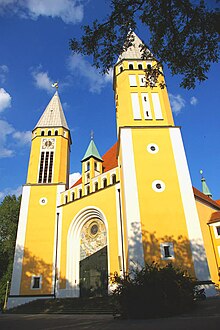To Our Lady of the Kreuzberg

The pilgrimage church to Our Lady of the Kreuzberg is a parish church on the Kreuzberg in Schwandorf ( Bavaria ). It is also the monastery church of the Carmelite Order .
history
Former church
After the Michael chapel was demolished in 1556, the "Spielberg" was used as a place of execution. At the beginning of the 17th century the gallows were torn down and three crosses were erected (Kreuzberg). In 1678 the first Lady Chapel was built by Pietro II Spineta. The Maria-Hilf-Bild was donated in 1679. From 1695 the pilgrimage was looked after by the Capuchins, who expanded the chapel into a four-bay church in 1698. In 1782 the church was enlarged again. In 1802 the Capuchin monastery was dissolved by secularization and taken over again from 1889 by the Carmelites who rebuilt the monastery next to the church in 1892.
The baroque church was almost completely destroyed in a bomb attack in 1945 on April 17, 1945 . Brother Edmund fell victim to the attack, while the rest of the priests managed to save themselves. The miraculous image of Mariahilf by Lucas Cranach the Elder remained intact.
Today's church
From 1949 to 1952 the reconstruction took place under Prior Father Alexander Schultes. The modern church was built according to plans by the Regensburg government master builder Franz Seraph Günther . The academic painter Blasius Spreng from Munich took over the artistic direction . On July 2, 1960, the church was inaugurated by Auxiliary Bishop Josef Hiltl .
organ
The organ was built in the years 1958-1960 by the organ building company Weise (Plattling). The instrument was based on organs of the 18th century scheduled . It has 48 registers (3753 pipes ) on three manuals and a pedal . The playing and stop actions are electro-pneumatic .
|
|
|
|
|||||||||||||||||||||||||||||||||||||||||||||||||||||||||||||||||||||||||||||||||||||||||||||||||||||||||||||||||||||||||||||||||||||||||||||||||||||||||||||
- Coupling : II / I, III / I, III / II, I / P, II / P, III / P
- Playing aids : Fixed combinations (pleno, tutti), free combinations, storage, crescendo roller
Bells
The church has six bells, some of which were cast by different bell foundries at the beginning of the 20th century, and some after World War II. The full bell can only be heard in exceptional cases.
| No. | Surname | Casting year | Caster | Ø (mm) | Mass (kg) | Nominal | inscription |
|---|---|---|---|---|---|---|---|
| 1 | Peace bell | 1958 | Court weaver Regensburg |
1630 | 2250 | b 0 | "Pax vevis ques defundis memento April 17th, 1945" |
| 2 | St. Michael | 1958 | Court weaver Regensburg |
1415 | 1600 | of the 1st | "Who is like God" |
| 3 | St. Theresa | 1951 | Petit & Edelbrock Gescher |
1210 | 1050 | it 1 | "The Carmelites of Schwandorf of their holy mother Theresia von Jems - 1951" |
| 4th | St. Mary | 1913 | Hamm Regensburg |
650 | f 1 | ||
| 5 | St. Joseph | 1913 | Hamm Regensburg |
400 | as 1 | ||
| 6th | Siegfried measuring bell |
1951 | Petit & Edelbrock Gescher |
250 | b 1 | "Dona nobis pacem - Anna Lautenschlager, Schwandorf, in memory of her fallen son Siegfried - 1951" |
Anti-WAA votive tablet
An anti WAA - votive tablet hangs in the chapel of the monastery church and has the following inscription:
“At this time, when our environment is threatened with destruction, through
poisoning of air, water and earth, our home Upper Palatinate is threatened with
nuclear contamination for us and future generations
due to the construction of a reprocessing plant. Mary, Mother of God,
patroness of our homeland , patroness of the Kreuzberg, ask for us
from your son to protect our homeland.
O Lord, spare us from poisoning the earth! "
literature
- Xaver Luderböck: Our Lady of the Kreuzberg Schwandorf (= Little Art Guide No. 854). Schnell and Steiner, Regensburg 2018.
- P. Lambert Stein (OCD): 100 years of the Carmelites on the Kreuzberg in Schwandorf. 1889-1989. Festschrift on the occasion of the 100th anniversary of the Carmelites on the Kreuzberg in Schwandorf . Abensberg 1989.
- Hans J. Utz: Pilgrimages in the diocese of Regensburg . Schnell and Steiner, Munich / Zurich 1981, p. 181.
Individual evidence
- ↑ Xaver Luderböck: Our Lady from Kreuzberg Schwandorf (= Small Art Guide No. 854). Schnell and Steiner, Regensburg 2018, p. 22f.
- ↑ Schwandorf, Carmelite Monastery on the Kreuzberg - (Christine Riedl-Valder, House of Bavarian History)
- ↑ More information on the Weise organ
- ↑ More information about the bells
Web links
Coordinates: 49 ° 19 ′ 12.1 ″ N , 12 ° 6 ′ 59 ″ E


